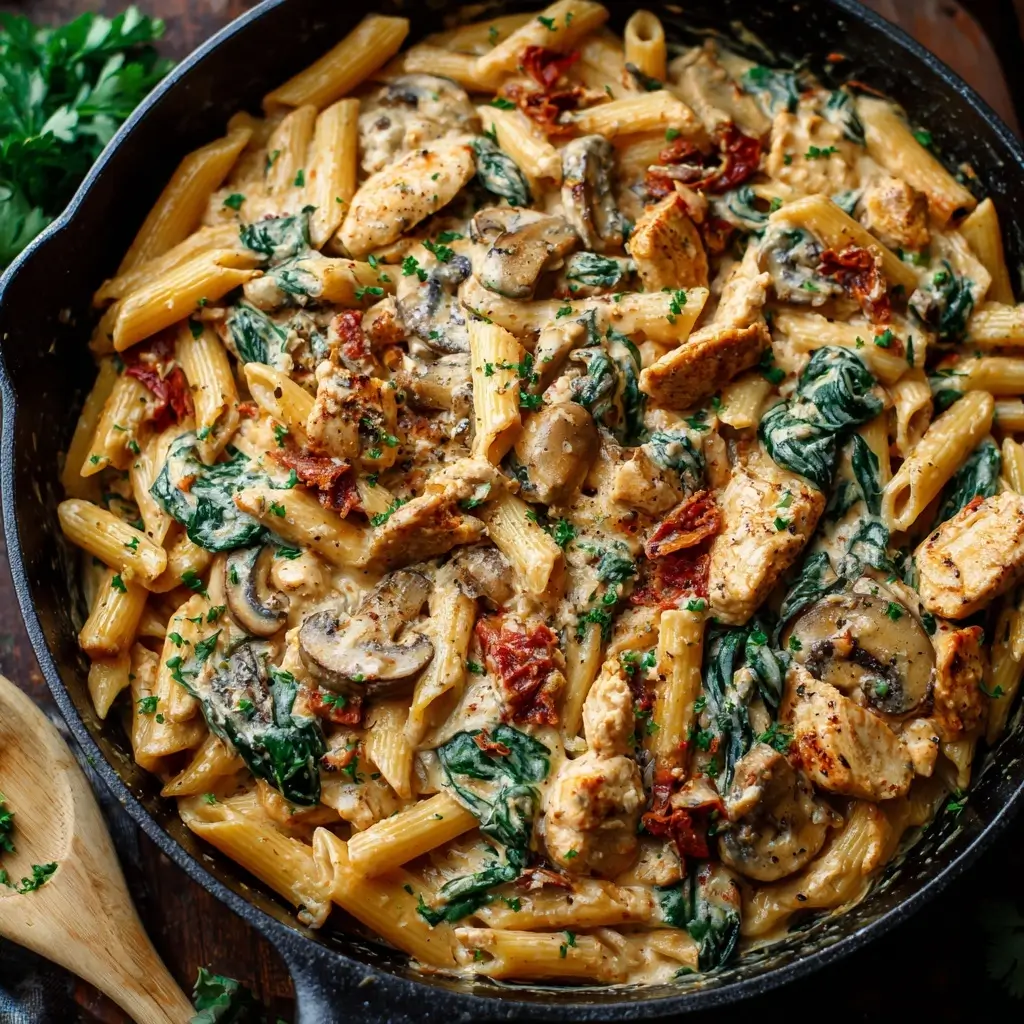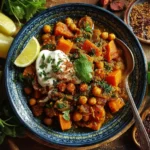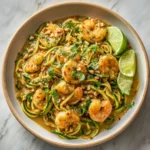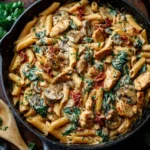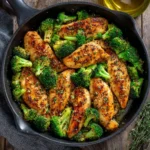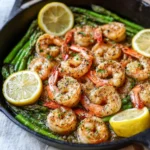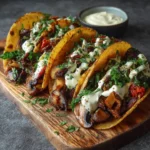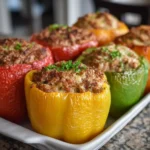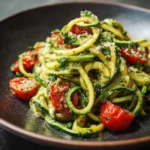Creamy Tuscan Chicken Pasta: A Luxurious Italian-Inspired Comfort Dish
Indulge in the rich, velvety flavors of Creamy Tuscan Chicken Pasta—a dish that brings the rustic elegance of Tuscany straight to your dinner table. With tender pieces of chicken breast, al dente pasta, sun-dried tomatoes, spinach, and a luscious creamy garlic sauce infused with Parmesan and herbs, this recipe is both comforting and sophisticated. Loved by home cooks and food enthusiasts alike, it’s a modern favorite that combines Mediterranean flair with American comfort food sensibilities. Whether you’re preparing a romantic dinner for two or a family feast, this one-pan wonder delivers on flavor, texture, and ease.
The History Behind Creamy Tuscan Chicken Pasta
While not a traditional Italian recipe from Tuscany itself, Creamy Tuscan Chicken Pasta is a contemporary creation inspired by the fresh ingredients and bold flavors associated with Tuscan cuisine. Originating in American culinary circles during the early 2010s, the dish quickly gained popularity through food blogs, social media platforms like Instagram and Pinterest, and cooking shows. It draws inspiration from classic Italian elements—such as olive oil, garlic, sun-dried tomatoes, and Parmesan—but incorporates a richer, cream-based sauce more typical of Americanized Italian dishes.
Tuscan cooking traditionally emphasizes simplicity, seasonal produce, high-quality olive oil, and minimalistic seasoning. However, this recipe elevates those principles into a more decadent format, balancing earthy greens, savory proteins, and indulgent dairy. The name “Tuscan” here acts as a culinary shorthand for Mediterranean-inspired freshness, evoking images of rolling hills, vineyards, and farmhouse kitchens. Over time, variations have emerged globally, adapting to local tastes while maintaining the core components that make it so beloved.
Ingredients Breakdown: What Makes This Dish Shine
The magic of Creamy Tuscan Chicken Pasta lies in its harmonious blend of premium ingredients, each contributing depth, texture, and aroma. Here’s a detailed breakdown:
- Chicken Breast: Boneless, skinless chicken breasts are ideal for their mild flavor and ability to absorb seasonings. They provide lean protein and a satisfying chew when cooked properly.
- Pasta (Fettuccine or Penne): Fettuccine offers a luxurious ribbon-like texture perfect for clinging to creamy sauces, while penne provides bite-sized pockets of flavor. Both work well depending on preference.
- Heavy Cream: The base of the sauce, heavy cream lends richness and body. For a lighter version, half-and-half or full-fat coconut milk can be substituted, though with slightly less silkiness.
- Chicken Broth: Adds depth and balances the heaviness of the cream. Low-sodium broth allows better control over salt levels.
- Garlic: Freshly minced garlic is essential for aromatic intensity. Sautéed gently to avoid bitterness, it forms the backbone of the sauce.
- Sun-Dried Tomatoes: Packed in oil or dry-packed, these bring a sweet-tart umami punch that cuts through the creaminess. Chopped finely, they distribute evenly throughout the dish.
- Fresh Spinach: Baby spinach wilts beautifully into the sauce, adding color, nutrients, and a subtle earthy note without overpowering other flavors.
- Parmaesan Cheese: Authentic Parmigiano-Reggiano is preferred for its nutty, salty complexity. Grated fresh ensures maximum meltability and flavor infusion.
- Butter and Olive Oil: Used together for sautéing, butter adds richness while olive oil contributes fruity notes and helps prevent burning at higher temperatures.
- Dried Herbs (Italian Seasoning, Thyme, Rosemary): A mix of oregano, basil, thyme, and sometimes rosemary enhances the Mediterranean profile. Fresh herbs can also be used toward the end for brighter taste.
- Red Pepper Flakes (optional): Just a pinch adds gentle heat and complexity without making the dish spicy.
- Salt & Black Pepper: Crucial for seasoning layers; best added incrementally to build balanced flavor.
- Flour (for thickening, optional): Sometimes used to create a roux or dust chicken before searing to help thicken the sauce naturally.
Each ingredient plays a role in creating a multi-dimensional experience—creamy yet bright, hearty yet refined.
Step-by-Step Recipe: How to Make Creamy Tuscan Chicken Pasta
Follow this easy, foolproof method to create a restaurant-quality meal at home using mostly one pan for minimal cleanup.
- Prepare Ingredients: Slice 2 large boneless, skinless chicken breasts into thin cutlets (about ½ inch thick). Season both sides generously with salt, black pepper, garlic powder, and paprika. Chop ¼ cup sun-dried tomatoes (if oil-packed, drain excess oil), mince 4 cloves garlic, grate ½ cup Parmesan cheese, and measure out 2 cups fresh baby spinach.
- Cook the Pasta: Bring a large pot of salted water to a boil. Add 12 oz fettuccine or penne and cook according to package instructions until al dente (usually 9–11 minutes). Reserve 1 cup of pasta water before draining. Set aside.
- Sear the Chicken: In a large deep skillet or Dutch oven, heat 2 tablespoons olive oil and 1 tablespoon butter over medium-high heat. Once hot, add chicken in a single layer (work in batches if needed). Cook 5–6 minutes per side until golden brown and internal temperature reaches 165°F. Remove chicken and set aside on a plate.
- Sauté Aromatics: In the same pan, reduce heat to medium. Add another tablespoon of butter if needed, then stir in minced garlic and ½ teaspoon red pepper flakes (if using). Sauté for 30 seconds until fragrant—do not let garlic burn.
- Add Sun-Dried Tomatoes and Broth: Stir in chopped sun-dried tomatoes and cook for 1 minute. Pour in 1 cup low-sodium chicken broth, scraping up any browned bits from the bottom of the pan (this adds tremendous flavor).
- Create the Cream Sauce: Slowly whisk in 1 cup heavy cream, followed by ½ teaspoon dried Italian seasoning, ¼ teaspoon dried thyme, and a pinch of nutmeg (optional but recommended). Bring to a gentle simmer and let cook for 3–4 minutes to slightly reduce.
- Incorporate Cheese: Reduce heat to low. Gradually stir in grated Parmesan cheese until fully melted and smooth. Taste and adjust seasoning with salt and pepper as needed.
- Add Spinach: Stir in 2 cups fresh spinach in batches, allowing each addition to wilt before adding more. This should take about 2 minutes.
- Return Chicken to Pan: Slice or chop the cooked chicken into bite-sized pieces and return to the skillet. Simmer gently for 2–3 minutes to reheat and allow flavors to meld.
- Combine with Pasta: Add the drained cooked pasta to the skillet. Toss everything together thoroughly, adding reserved pasta water ¼ cup at a time until desired creaminess is achieved. The starch in the pasta water helps emulsify the sauce and bind it to the noodles.
- Garnish and Serve: Transfer to serving plates. Top with extra Parmesan, a sprinkle of fresh parsley or basil, and a drizzle of olive oil if desired. Serve immediately.
Tips for Perfect Creamy Tuscan Chicken Pasta Every Time
- Don’t Overcook the Chicken: To keep it juicy, avoid overcrowding the pan when searing. Use a meat thermometer to ensure it hits 165°F without going beyond.
- Use Room-Temperature Cream: Cold cream can curdle when added to hot pans. Let it sit out for 10–15 minutes before use.
- Reserve Pasta Water: This starchy liquid is gold—it helps thicken and bind the sauce seamlessly to the pasta.
- Season in Layers: Season chicken, then the sauce, then again at the end. This builds complex, well-rounded flavor.
- Avoid Boiling the Cream Sauce: After adding cream and cheese, keep heat low to prevent separation or scorching.
- Let It Rest Briefly: Allow the finished dish to sit for 2–3 minutes before serving; this lets the sauce settle and cling better to the pasta.
- Prep Ahead: Chop all ingredients before starting. This recipe moves quickly once cooking begins.
- One-Pan Option: If you want fewer dishes, cook the pasta, drain, then use the same pot for the rest of the recipe after rinsing briefly.
Variations and Customizations
This versatile recipe welcomes creativity. Try these delicious twists:
- Creamier Version: Add 2–3 tablespoons mascarpone or cream cheese for an even silkier, richer texture.
- Seafood Twist: Replace chicken with seared scallops or shrimp for a luxurious Creamy Tuscan Seafood Pasta.
- Mushroom Lover’s: Sauté sliced cremini or shiitake mushrooms with the garlic for an earthy depth.
- Dairy-Free/Vegan: Substitute coconut cream for heavy cream, nutritional yeast for Parmesan, and use plant-based chicken alternatives. Add capers for a briny kick.
- Gluten-Free: Use gluten-free pasta (like brown rice or chickpea-based) and ensure broth and sun-dried tomatoes are GF-certified.
- Low-Carb/Keto: Swap pasta for spiralized zucchini (zoodles), cooked separately and added at the end. Increase healthy fats with extra olive oil or avocado slices.
- Extra Veggies: Add roasted red peppers, artichoke hearts, peas, or broccoli florets for more color and nutrition.
- Herb Variations: Swap Italian seasoning for herbes de Provence or add fresh sage for a woodsy note.
- Lemon Zest Boost: Finish with lemon zest or a splash of lemon juice to brighten the richness.
- Bacon or Pancetta: Crisp up some bacon or pancetta at the start, then use the rendered fat to sauté the chicken for smoky depth.
Health Considerations and Nutritional Value
Creamy Tuscan Chicken Pasta is undeniably rich, but with mindful adjustments, it can fit into a balanced diet. Here’s a general nutritional breakdown per serving (based on 4 servings):
- Calories: ~650–750 kcal
- Protein: ~35–40g (excellent source from chicken and cheese)
- Fat: ~30–40g (mostly saturated from cream and cheese; consider light substitutions if needed)
- Carbohydrates: ~50–60g (primarily from pasta; choose whole grain for added fiber)
- Fiber: ~4–6g (enhanced with spinach and whole-grain pasta)
- Sodium: ~800–1,200mg (can be reduced by using low-sodium broth and limiting added salt)
Health Tips:
- Opt for low-fat milk or evaporated milk instead of heavy cream to reduce calories and fat.
- Use part-skim mozzarella or reduced-fat Parmesan sparingly, though flavor may diminish.
- Increase vegetable content by doubling the spinach or adding other greens like kale or arugula.
- Portion control is key—serve with a side salad or steamed vegetables to balance the meal.
- Omega-3s can be boosted by topping with toasted pine nuts or walnuts.
- Those managing cholesterol should monitor intake of cream and cheese, opting for plant-based alternatives when possible.
Full Ingredient List
- 2 boneless, skinless chicken breasts (about 1 lb)
- 12 oz fettuccine, penne, or rigatoni
- 2 tbsp olive oil (plus more as needed)
- 2 tbsp unsalted butter (divided)
- 4 cloves garlic, minced
- ¼ cup sun-dried tomatoes (chopped)
- 1 cup low-sodium chicken broth
- 1 cup heavy cream (or substitute)
- ½ cup freshly grated Parmesan cheese (plus extra for garnish)
- 2 cups fresh baby spinach
- ½ tsp dried Italian seasoning
- ¼ tsp dried thyme
- ½ tsp garlic powder
- ½ tsp smoked paprika (optional)
- ¼ tsp red pepper flakes (optional)
- Salt and freshly ground black pepper (to taste)
- 1 tbsp all-purpose flour (optional, for dredging chicken)
- 1 cup reserved pasta water
- Fresh parsley or basil (chopped, for garnish)
Detailed Cooking Directions
Reiterating the full process with precision for optimal results:
- Pat chicken breasts dry and slice horizontally into thinner cutlets. Season both sides with salt, pepper, garlic powder, and paprika. Optionally, lightly coat with flour for a crispier sear.
- Bring a large pot of salted water to a rolling boil. Add pasta and cook until just shy of al dente (about 1 minute less than package directions). Drain, reserving 1 cup of starchy cooking water.
- Heat olive oil and 1 tbsp butter in a large skillet over medium-high heat. Add chicken in a single layer and cook 5–6 minutes per side until golden and cooked through. Transfer to a plate and cover loosely with foil.
- Reduce heat to medium. Melt remaining butter in the same pan. Add garlic and red pepper flakes; sauté 30 seconds until fragrant.
- Add sun-dried tomatoes and stir for 1 minute. Pour in chicken broth, scraping the bottom to lift flavorful fond.
- Whisk in heavy cream, Italian seasoning, and thyme. Bring to a gentle simmer and cook 3–4 minutes to reduce slightly.
- Lower heat to minimum. Gradually whisk in Parmesan until smooth and creamy. Avoid boiling to prevent separation.
- Stir in spinach in batches until wilted and incorporated.
- Cut or slice chicken into strips and return to the pan. Simmer 2–3 minutes to reheat.
- Add cooked pasta and toss well. Begin incorporating reserved pasta water ¼ cup at a time until sauce coats the noodles luxuriously.
- Taste and adjust seasoning—add salt, pepper, or a squeeze of lemon juice if desired.
- Remove from heat. Garnish with extra Parmesan, fresh herbs, and a drizzle of olive oil.
- Serve immediately while hot and creamy.
Frequently Asked Questions (FAQ)
Can I make Creamy Tuscan Chicken Pasta ahead of time?
Yes, though it’s best served fresh. You can prep ingredients (chop veggies, season chicken) up to 24 hours in advance. Cooked leftovers keep well refrigerated for 3–4 days and reheat gently on the stove with a splash of broth or cream to restore creaminess.
Why did my sauce separate?
Dairy-based sauces can split due to high heat, rapid temperature changes, or acidic ingredients. Always use low heat after adding cream and cheese, and avoid boiling. If separation occurs, remove from heat, stir in a spoonful of cold cream, and blend with an immersion blender if available.
Can I freeze this dish?
Freezing is not recommended due to the dairy content. Cream and cheese tend to become grainy upon thawing and reheating. Store in the refrigerator only.
What pasta works best?
Fettuccine, penne, rigatoni, and farfalle all hold the sauce well. Choose based on texture preference—ribbons vs. tubes vs. bows.
Is there a lighter version?
Absolutely! Use whole wheat pasta, substitute half the cream with milk or Greek yogurt, increase spinach, and reduce cheese. You can also bake the chicken instead of pan-searing to cut down on added fats.
Can I use frozen spinach?
Yes, but thaw completely and squeeze out excess moisture to avoid watering down the sauce. About 1 cup cooked frozen spinach equals 2 cups fresh.
How do I store leftovers?
Cool within 2 hours and store in an airtight container in the fridge for up to 4 days. Reheat slowly on the stovetop with a little liquid to refresh the texture.
Can I cook this in a slow cooker?
Not ideal due to the delicate cream and cheese, which may curdle. However, you can brown the chicken and sauté aromatics first, then transfer to a slow cooker with broth and simmer for 4–6 hours on low. Add cream, cheese, and spinach in the last 30 minutes.
Summary
Creamy Tuscan Chicken Pasta is a sumptuous fusion of Italian inspiration and American comfort, featuring tender chicken, al dente pasta, and a luxuriously creamy garlic-Parmesan sauce accented with sun-dried tomatoes and spinach.
Easy to customize, rich in flavor, and perfect for weeknight dinners or special occasions, this dish brings the taste of Tuscany into your kitchen with every satisfying bite.
